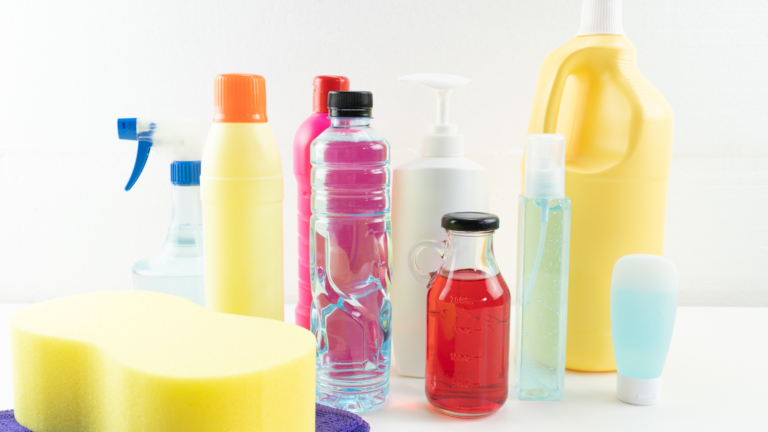
Are there toxins in their active ingredients?
One of the main goals of biomedical and life science research is to figure out how environmental exposures affect the body’s line of defense.
Several investigations have examined the relationship between exposure to environmental chemicals and epigenetics in the last few years. As a result, several toxicants were identified to modify epigenetic markers due to exposures that increase the risk of developing certain diseases.
What If the Products are Natural?
Household and cleaning products labeled as “green” or “natural” products may contain toxic ingredients that can cause health issues as they also decimate your microbiome. This problem happens because many of the potent chemical components in cleaning products are non-selective. They kill probiotic organisms and unwanted types of bacteria.
In addition to specific gut changes triggered by exposure to certain antimicrobials, it is essential to consider the “hygiene hypothesis.” This insight implies that when antimicrobials are excessively used, young immune systems have nothing to practice, which can result in susceptibility to troublesome microbial invaders over time.
What are the Hidden Toxins in Your Cleaning Products?
Sanitizing is frequently viewed as an all-out war to eradicate pathogens and protect our health in our homes, schools, and work environments.
However, many “natural” or “gentle” cleansers are not natural or gentle despite their labels. There is evidence that these common cleaning product ingredients can pose health risks. Hence, it is appropriate to avoid the following components:
- Butoxyethanol (2-Butoxyethanol) is a common component of all-purpose cleaners. It is a compound used as an industrial solvent in manufacturing ingredients for cleaning products. Typically labeled as “Nonionic surfactants,” “butoxyethanol,” and “ethylene glycol,” and can be added directly to cleaning products as a surfactant. Exposure to 2-Butoxyethanol may destroy red blood cells resulting in the release of hemoglobin, known as hemolysis.
- Ammonia (NH3) is one of the most widely produced chemicals in the United States. It is a colorless, highly irritating gas with a pungent, suffocating odor. Ammonium hydroxide, also called household ammonia, is an ingredient in many cleaning solutions used to clean various surfaces, such as tiles, tubs, sinks, and countertops. Home grime or stains, such as cooking grease and wine, can be effectively removed with ammonia. There are serious health risks associated with ammonia, such that when this substance enters the body either through inhaling, ingesting, or contact with the skin, it immediately produces ammonium hydroxide. This substance is highly corrosive and severely harms cells in the body upon contact.
- Chlorinated Bleaches. Used to disinfect and eliminate stains and odors. A potent antimicrobial and respiratory irritant, bleach is crucial in mildew removers, toilet bowl cleaners, and scouring powders. Bleach is corrosive and can irritate or burn the skin and eyes. When mixed with certain other cleaners, it can produce toxic gases like hypochlorous acid (HOCl) and chlorine gas (Cl2), which can be fatal and, at the least, cause severe lung damage.
- Phthalates. A plasticizer softens plastics and stabilizes fragrances found in many aerosol air fresheners. Phthalates are not chemically bound to plastics and can leach from plastic packaging. Commonly only listed as ‘fragrance’ or ‘perfume,’ this is widely used in detergents, soaps, cleaning supplies, and air fresheners which are added to products for fragrance or to hide the smell of other components.
The volatile organic compounds (VOCs) released by fragrance items can contribute to poor indoor air quality (IAQ), and as studies have shown, these fragranced products can induce adverse health effects.
Numerous fragrance components are respiratory irritants and sensitizers, which can provoke asthma attacks and worsen sinus disorders.
- Quaternary Ammonium Compounds (QUATS). Usually labeled as ‘Preservatives,’ ‘benzalkonium chloride,’ or ‘quaternium-15’, this is commonly used for Cationic surfactants to reduce surface tension and disperse dirt, increasing the effectiveness of detergents and fabric softeners.
Found in antibacterial household cleaners, fabric softeners, and dryer sheets. Studies have indicated QUATS as the cause of respiratory issues in cleaning workers. This exposure results in liver and white blood cell DNA damage.
- Sodium Hydroxide. Also referred to as caustic soda and lye. The solid form of sodium hydroxide at room temperature is white and odorless, whereas the liquid is colorless and odorless.
It is a synthetic chemical substance that is highly corrosive and is used as a chemical reagent to produce soap and cleaners. Often it is found in many oven cleaners and drain openers.
Sodium hydroxide can cause severe burns and blindness if it comes into contact with the eyes. Inhaling sodium hydroxide dust or powder can cause severe lung damage.
- Sodium Lauryl Sulfate (SLS), an anionic surfactant, is naturally derived from coconut and palm kernel oil.
It is used extensively in household cleaners such as powder laundry detergent, powder dish detergent, engine degreasers, floor cleaners, car wash soaps, toothpaste, shampoos, shaving foams, bubble baths, and carpet powder.
Sodium lauryl sulfate can cause allergic reactions in the eyes and skin. Inhalation may induce a severe allergic respiratory response with a sore throat, coughing, shortness of breath, and delayed lung edema.
- Triclosan (TCS). This antimicrobial agent is used in many products, including dish liquid, soap, deodorant, toothpaste, and even mops.
In addition to impacting microbial balance and infiltrating living tissue, Triclosan can also lead to increased environmental sensitivity and harmful cellular and endocrine changes. Most of the time, labeled as a preservative, Triclosan, TCS, is considered one of the most common chemicals in human breast milk. The compound is estrogenic androgenic so it may disrupt hormone regulation.
Conclusion
Our DNA is consistently exposed and damaged by both endogenous processes and external insults.
DNA damage and genetic disorders happen as chemical contaminants from household cleaning products modify multiple processes that affect epigenetic mechanisms, including DNA methylation, histone codes, and miRNA expression.
As more consumers are exposed to these environmental toxins, the likelihood of developing certain diseases becomes imminent. Hence, to avoid epigenetic alterations, efficient and practical measures must be taken by practicing the following:
- Reducing the use of these cleaning solutions;
- Ensuring that the product is ‘free of the above toxic substances’;
- Make it a habit to read all labels on these cleaning products;
- And whenever feasible, it is best to choose milder alternatives.
Check out the ingredients in your household cleaning products and find out if they pose a threat to your family. It pays to be informed!


